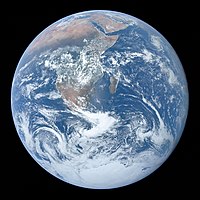
Photo from wikipedia
Astrobiologists interested in the possibility of life elsewhere in the universe have put a lot of emphasis on the concept of the habitable zone – the region around a star… Click to show full abstract
Astrobiologists interested in the possibility of life elsewhere in the universe have put a lot of emphasis on the concept of the habitable zone – the region around a star considered suitable for planetary based life. The most usual definition of this zone is the region in which liquid water could exist on a planet. This emphasis on the importance of liquid water for life (or at least Earth-like life) nicely illustrates the key role of temperature in ecology. In a new book, written in active retirement, Andrew Clarke synthesizes a lifetime’s work on the relationships between organisms and temperature. A great strength of the book is its combination of biology (including field natural history after all its organisms in ‘the field’ that we really want to understand as ecologists), and clear explanations of the relevant physics. Indeed, I found the clarity of the explanations remarkable for a researcher, rather than a teacher. Such a clear understanding of the physics is crucial, and the first third of the book concentrates on this background physical science, albeit leavened with biological examples. One of Clarke’s take home messages at the end of the book is that ‘Thermodynamics matters’, and I would go further and argue that it is absolutely central to ecology in general, as well as to thermal ecology in particular. The chapters come with extensive end notes which allow some elaboration of the background physics and chemistry. In addition, many of these notes relate to the history of the field, and key researchers from the past. In this respect it reminds me of G. Evelyn Hutchinson’s (1978) book An introduction to population ecology which also had abundant footnotes, many on the history of the subject. The notes in both Clarke and Hutchinson provide a quirky but well-informed entry into the history of their respective fields of ecology. In addition, Clarke’s 58 page long reference list, ranging from key historical publications which are often overlooked these days to the most recent research, forms an invaluable way into the thermal ecology literature. Following on from the opening chapters on the key physical science background of thermal ecology (energy and heat, temperature, energy flow, reaction rates, etc) the book considers standard topics from physiological ecology, such as metabolism, temperature regulation and endothermy. The final part of the book considers thermal ecology at larger scales – such as the metabolic theory of ecology, temperature and diversity (why are there so many tropical species?) and global climate change. One of my few quibbles with this book is the fact that a large proportion of these chapters are dominated by animal examples. This makes sense in the context of the author’s experience, and also probably in the balance of the research literature. However, to a first approximation animals make up almost 0% of biological diversity. A nice example of the importance of this is the book’s table (table 8.2) showing a classification of organisms based on their sources of energy and carbon. It makes no mention of mixotrophy however this is an extremely common way of making a living amongst a diverse range of microorganisms (indeed mixotrophy is also absent from almost all general ecology texts!). RecentlyNature Ecology andEvolution published a list of the top 100 papers all ecologists should read. The absence of books from this listing was striking. Any listing of the 100 most influential ecology publications would contain numerous books. When it comes to synthesis often a paper is just not long enough to really succeed, nor is it usually allowed to be idiosyncratic enough to transmit a personal view of a field. Clarke’s book is a good example of what, superficially, appears to be a ‘mere’ text book, but because of the clarity of understanding and wide reach of the ideas it provides an important synthesis of the entire field. In summary it is very good indeed and almost any ecologist would benefit from getting a copy and reading it.
Journal Title: Antarctic Science
Year Published: 2018
Link to full text (if available)
Share on Social Media: Sign Up to like & get
recommendations!